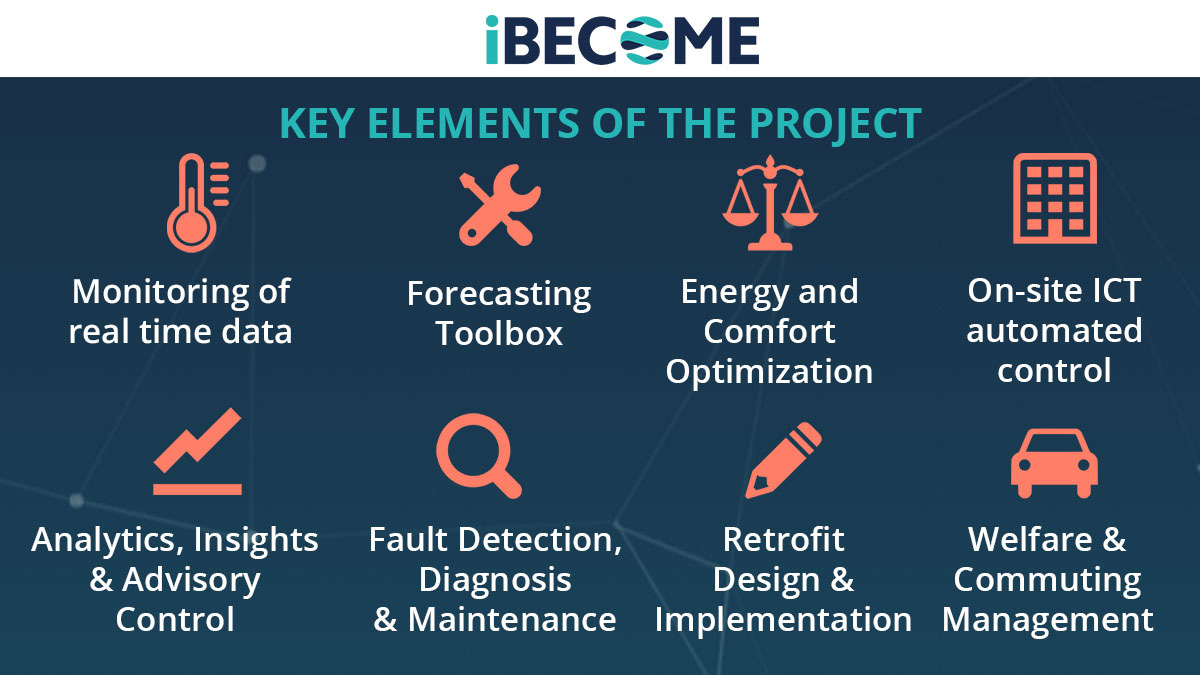
Intelligent Control for Comfort, Energy and Flexibility Optimisation
The EU-funded iBECOME project aims to increase intelligence, decarbonisation and decentralisation of the energy system by transforming building and operation data into products that can be profitable in the innovative business framework.
More precisely, a virtual Building Management System (vBMS) for optimising buildings energy performance and comfort conditions, while reducing the operational costs by leveraging demand response will be utilised.
First year highlights
IEQ Virtual Sensors
Computational methods to predict the Indoor Environmental Quality (IEQ) within a room, by using hybrid models that combines physics-based simulations and real data processing using machine learning techniques have been developed. The models are able to predict thermal comfort, illuminance, glare probability and pollutants concentration within a room with, accuracy ranging between 60-95%. In comparison, the PMV method predicts thermal comfort with accuracy ranging between 30-40%.
Automation of Building Energy Model Calibration
The process to produce accurate digital twins of buildings, essential for the vBMS to perform predictions of the future conditions has improved. Up until now, the calibration methodology was a desktop study that includes an intensive manual iterative process, followed on desktop application, and relies mostly on the experience of the energy modeller. The Apache Engine, which is the core simulation engine of the IES Virtual Environment can now operate on the cloud and enables the automation of many of the manual steps required in the calibration process. After testing the new method on a case study building the duration of calibration process was reduced by a remarkable 98%, while the accuracy was improved by 27% in average.
Co-Simulation
Further to the cloudification of the Apache Engine, the co-simulation capability was enabled. The physics-based simulation engine, which, is now capable to run in parallel with a machine learning model and to interact with it in every timestep of the simulation. This way real and virtual sensors towards the most accurate predictions of the future building conditions can be combined. This will be used to inform a number of control functions for optimising building operations at each timestep.
Next Steps
The work will continue in the next six months to finalise the software and hardware architecture of the vBMS, and the development of innovative computational methods to implement automated control of building energy systems in order to maximise comfort and minimise energy use. Furthermore, innovative solutions for Fault Detection, Predictive Maintenance, M&V and Demand Response services will be developed. Additional services will also be established including healthcare management for the elderly, a car sharing app and optimised EV charging.
See the EU factsheet for more information on this project.
- Reference
- H2020-EU.3.3.1. - Reducing energy consumption and carbon footprint by smart and sustainable use
- Project duration
- 1 Jun 2020 - 30 Nov 2023
- Project locations
- Ireland
- Overall budget
- €4 920 940
- EU contribution
- €3 724 50075.7% of the overall budget
- Project website
- iBECOME
- Departments
- European Climate, Infrastructure and Environment Executive Agency
Stakeholders
Coordinators
IES R&D
- Address
- Castleforbes House, Castleforbes Road, Dublin, Co. Dublin, Ireland
